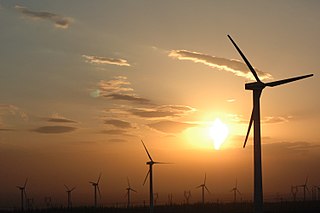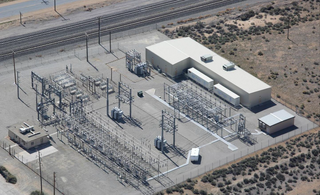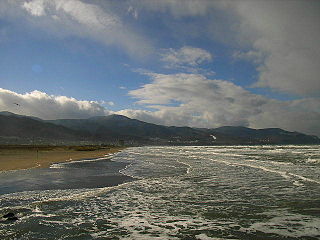
Electricity generation is the process of generating electric power from sources of primary energy. For utilities in the electric power industry, it is the stage prior to its delivery to end users or its storage, using for example, the pumped-storage method.

Wind power is the use of wind energy to generate useful work. Historically, wind power was used by sails, windmills and windpumps, but today it is mostly used to generate electricity. This article deals only with wind power for electricity generation. Today, wind power is generated almost completely with wind turbines, generally grouped into wind farms and connected to the electrical grid.

A wind farm or wind park, also called a wind power station or wind power plant, is a group of wind turbines in the same location used to produce electricity. Wind farms vary in size from a small number of turbines to several hundred wind turbines covering an extensive area. Wind farms can be either onshore or offshore.

The United Kingdom is the best location for wind power in Europe and one of the best in the world. The combination of long coastline, shallow water and strong winds make offshore wind unusually effective.

Wind power has been used as long as humans have put sails into the wind. Wind-powered machines used to grind grain and pump water — the windmill and wind pump — were developed in what is now Iran, Afghanistan, and Pakistan by the 9th century. Wind power was widely available and not confined to the banks of fast-flowing streams, or later, requiring sources of fuel. Wind-powered pumps drained the polders of the Netherlands, and in arid regions such as the American midwest or the Australian outback, wind pumps provided water for livestock and steam engines.
Siemens Gamesa Renewable Energy, S.A. was formed in 2017 in a merger of Siemens' Wind Power division with Gamesa Corporación Tecnológica, S.A.; it is a Spanish-German wind engineering company based in Zamudio, Biscay, Spain. The company has two other main sites in Spain: one in Madrid and the other in Sarriguren. Other than its headquarters, its onshore business is primarily based in Spain, while the offshore business is based in Germany and Denmark. It is the world's second largest wind turbine manufacturer behind Vestas.

Whitelee Wind Farm is a windfarm on the Eaglesham moor in Scotland. The main visitor centre is located in East Renfrewshire, but the majority of turbines are located in East Ayrshire and South Lanarkshire. It is the largest on-shore wind farm in the United Kingdom with 215 Siemens and Alstom wind turbines and a total capacity of 539 megawatts (MW), with the average of 2.5 MW per turbine. Whitelee was developed and is operated by ScottishPower Renewables, which is part of the Spanish company Iberdrola.

A floating wind turbine is an offshore wind turbine mounted on a floating structure that allows the turbine to generate electricity in water depths where fixed-foundation turbines are not feasible. Floating wind farms have the potential to significantly increase the sea area available for offshore wind farms, especially in countries with limited shallow waters, such as Spain, Portugal, Japan, France and the United States' West Coast. Locating wind farms further offshore can also reduce visual pollution, provide better accommodation for fishing and shipping lanes, and reach stronger and more consistent winds.
GE Offshore Wind is a joint venture with Alstom and a subsidiary of GE Renewable Energy, created in 2015 when most of Alstom's electrical power and generation assets were acquired by General Electric. GE's stake in the joint venture is 50% plus 1 share.

In Japan's electricity sector, wind power generates a small proportion of the country's electricity. It has been estimated that Japan has the potential for 144 gigawatts (GW) for onshore wind and 608 GW of offshore wind capacity. As of 2023, the country had a total installed capacity of 5.2 GW.
Dogger Bank Wind Farm is a group of offshore wind farms under construction 130 to 200 kilometres off the east coast of Yorkshire, England in the North Sea. It is considered to be the world's largest offshore windfarm. It was developed by the Forewind consortium, with three phases envisioned - first phase, second phase and third phase. In 2015, the third phase was abandoned, while the first and second phases were granted consent. It was initially expected that the Dogger Bank development will consist of four offshore wind farms, each with a capacity of up to 1.2 GW, creating a combined capacity of 4.8 GW. As of 2023, a total of 277 turbines are expected to be built and produce a capacity of 3.6 GW, enough to power 6 million homes.

A battery storage power station, or battery energy storage system (BESS), is a type of energy storage power station that uses a group of batteries to store electrical energy. Battery storage is the fastest responding dispatchable source of power on electric grids, and it is used to stabilise those grids, as battery storage can transition from standby to full power in under a second to deal with grid contingencies.
Wind power is a form of renewable energy in South Korea with the goal of reducing greenhouse gas (GHG) and particulate matter (PM) emissions caused by coal based power. After two oil crises dating back to the 1970s, the South Korean government needed to transition to renewable energy, which encouraged their first renewable energy law in 1987.
The Hornsdale Wind Farm is an electricity generator in the locality of Hornsdale in the south-west of the Narien Range, north of Jamestown, South Australia. It consists of 99 wind turbines with a generation capacity of 315 megawatts (422,000 hp). The plant is owned and operated by Neoen, a French renewable energy company.

Ishikari Bay is a bay located in Hokkaido of Japan, connected to the Sea of Japan. Ishikari Bay is the area east of the straight line from Cape Shakotan on the west of Shakotan Peninsula to Cape Ofuyu.
South Fork Wind Farm is a utility-scale offshore wind farm on the Outer Continental Shelf Offshore Rhode Island, providing energy to New York state.
ACEN Corporation, formerly AC Energy, is the energy firm under the Ayala Group. The company has over 4,000 MW of attributable capacity in the Philippines, Vietnam, Indonesia, India, and Australia, with a renewable share of 98% which is among the highest in the region.

Vineyard Wind 1 is an offshore wind farm under construction in U.S. federal waters in the Atlantic Ocean in Bureau of Ocean Energy Management-designated Lease Area OCS-A 0520, about 13 nautical miles south of Martha's Vineyard and Nantucket, Massachusetts. The array is designed to include 62 Haliade-X wind turbines manufactured by GE Offshore Wind with a nameplate capacity of 804 MW combined, equivalent to the annual power use of 400,000 homes. The Massachusetts Department of Public Utilities approved the project in 2019. Construction began on November 18, 2021. In October 2023, the first turbine was installed. Power from the first turbine started flowing into the ISO New England grid on January 2, 2024. Construction is expected to be complete by the end of 2024.














